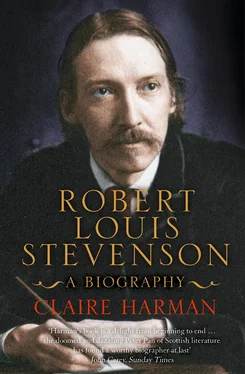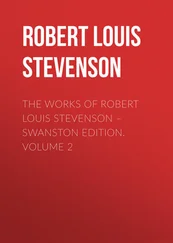The winter of 1870–71 saw Stevenson’s first real opportunity to associate with other would-be writers, and the effect was galvanising. Three law students in the Speculative Society, James Walter Ferrier, Robert Glasgow Brown and George Omond, approached Stevenson to join them in editing a new periodical, the Edinburgh University Magazine. They had already found a publisher (the local booksellers), and were going to share the expenses and the profits. Of course, the likelihood of there being profits was nil and the magazine only ran for four issues, but in those four Stevenson published six articles and edited one whole number on his own. Being recognised as a fellow writer was ‘the most unspeakable advance’, he said later: ‘it was my first draught of consideration; it reconciled me to myself and to my fellow-men’. 65
Ferrier, the golden youth of this group, was to become one of Stevenson’s best friends. Witty, wealthy and devastatingly handsome, he seemed destined for great things and was the first of these ambitious young writers to publish a book, a novel called Mottiscliffe: An Autumn Story. Robert Glasgow Brown also had early literary success, founding a weekly magazine called London in 1877, to which Stevenson and most of their group contributed. Louis’s best friend, however, was a young lawyer whom he had known socially through attending the same Edinburgh church, St Stephen’s. Charles Baxter was two years older than Louis and had graduated from the university in 1871, entering his father’s chambers as an apprentice. Temperamentally the two young men had much in common: Baxter was idle, sentimental, and ready for any sort of practical joking. He was the ideal drinking companion and had a droll turn of phrase that was a perfect foil for Louis’s high spirits and semi-hysterical flights of fancy. An anecdote that Baxter told of his first visit to Swanston makes it easy to see what Louis valued in this amiable youth:
That night, late, in his bedroom, after reading to me (I think) ‘The Devil on Crammond Sands’, he flung himself back on his bed in a kind of agony exclaiming, ‘Good God, will anyone ever publish me!’ To soothe him, I (quite insincerely) assured him that of course someone would, for I had seen worse stuff in print myself. 66
Baxter was put up for the Spec by Stevenson and became Secretary (he was always good with procedure, as befitted his profession). But their happiest times were spent on the streets of Edinburgh, engaged in jokes against fogeys such as the ill-tempered wine merchant Brash, whom Stevenson made the hero of a set of ribald verses, or talking to each other in ludicrously broad Scots, in the character of two old Edinburgh lawyers, Johnson and Thomson. Spontaneous jokes were their speciality, like the time they followed six men carrying a wrapped sheet of glass down George Street, as if they were chief mourners, hats off and heads bowed. As Louis wrote in one of his ‘Brasheana’ poems, ‘Let us be fools, my friend, let us be drunken,/Let us be angry and extremely silly.’ 67
In the spring of 1871 Louis was called on to give a paper to the Royal Scottish Society of Arts, and made a fair effort at pleasing both the examining committee and his father. One of the examiners was his professor of engineering, Fleeming” Jenkin, whose early dealings with the student had not been promising. Stevenson had applied to him for one of the necessary certificates of attendance at the end of the first year, only to be told that as far as the professor was aware, his attendance had been nil. ‘It is quite useless for you to come to me, Mr Stevenson,’ Jenkin had said. ‘There may be doubtful cases; there is no doubt about yours. You have simply not attended my class.’ 68 The frankness of this impressed the truant, and Jenkin turned out to be one of the few older men towards whom Louis showed admiration and respect.
‘On a New Form of Intermittent Light’ is very short for a paper – ten pages of large writing, the last sentences of which have been written in a different ink and possibly a different hand: ‘It must however, be noted, that none of these last methods are applicable to cases where more than one radiant is employed: for these cases either my grandfather’s or Mr Wilson’s contrivance must be resorted to’ 69 – an anxious note, which suggests Thomas Stevenson looking over his boy’s first contribution to science. The substance of Louis’s proposal is that a revolving hemispherical mirror could be used in conjunction with a fixed mirror to make lighthouse lights flash. The ‘revolving’ part of this idea was ingenious, though from his very rudimentary diagrams it is clear that the student had given little thought to the technical and logistical difficulties. Nevertheless, Jenkin and his colleagues judged the paper ‘specially noteworthy’ and later in the year awarded this latest scion of the Stevenson family a silver medal for his trouble. *
Thomas Stevenson was, presumably, not so impressed by his son’s performance, for it was only about ten days later that he chose an evening walk as the occasion to grill Louis on his intentions. The conversation was painful and upsetting for both, for the youth, ‘tightly cross-questioned’, 71 confessed that he cared for nothing but literature. Thomas had at last to swallow the fact that the experiment had gone on long enough, and had been a failure. Louis had spent four years studying at the university, three summers on the works, he had worked in a carpenter’s shop, a foundry and a timberyard, and still couldn’t tell one kind of wood from another or make the most basic calculations. They were flogging a dead horse.
An alternative career on ‘the devious and barren paths of literature’, as Thomas described it, 72 was out of the question, however. If the boy was going to abandon the family business, he had at least to train for a similarly dignified and worthy profession. He would have to study for the Bar. ‘Tom wonderfully resigned’, his wife noted in her diary on hearing the news, but though he had to accept the defeat as well as he could, Thomas Stevenson never got over the bitter disappointment of this day, and was still complaining about it in the last years of his life.
So Stevenson, after almost four years, was released from the yoke of engineering. He was going back to the university in the autumn to begin all over again as a student of law. Which was not to say he had any intention of becoming a lawyer.
* W.E. Henley, who didn’t meet RLS until six years after this change, always attempted to use the earlier spelling, though this might have been as much affectation as anything.
* Storms in the winters of 1868, 1871 and 1872. destroyed large parts of the breakwater. The failure of the project was later described by RLS as ‘the chief disaster of my father’s life’. 24
* RLS reminisced so warmly about his original velvet jacket once he was married that his wife got him a replacement made of velveteen, renewed serially thereafter. 45
* There was a long-running myth that a mysterious lassie called ‘Kate Drummond’ was the love of the young RLS’s life, and the mistaking of one of RLS’s names for Mrs Sitwell – ‘Claire’ – also led to confusion until J.C. Furnas showed that she and Mrs Sitwell were one and the same.
* David Stevenson junior had a much curter judgement of the paper when approached by Graham Balfour for his professional opinion many years later, saying there were ‘several objections’ to his dilettante cousin’s notion. 70
Was early life laborious? Why and how? [ … ] The ‘how’ will distinguish various forms of mental fret and exhaustion from one another and from muscular fatigue.
Francis Galton, Record of Family Faculties
Читать дальше












